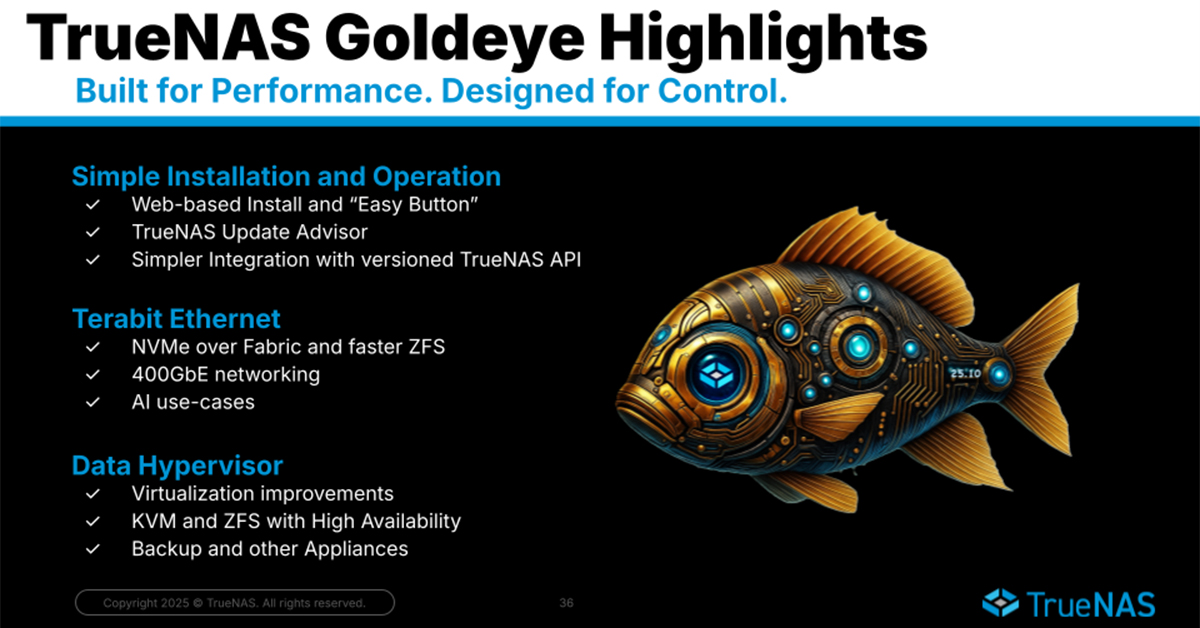Nightly builds of TrueNAS 25.10 are available now for development and testing. Beta releases in late August will gather community feedback ahead of the October launch. Enterprise-ready recommendations will follow in early 2026.
TrueNAS Goldeye significantly improves top-end performance and control of both single and fleet systems.

Simple Install and Updates
Historically, the initial setup of TrueNAS required a customized USB stick, a keyboard and monitor, or a serial console cable. Given the pace of hardware changes, the desire for faster deployments, and ease of use improvements, we’ve integrated a simpler, web-based installation process into TrueNAS Goldeye.
The new installation process starts with web-based guidance on the USB creation and system boot process. The installer now starts up a secure, API-driven installation process in conjunction with a free cloud service, helping you install TrueNAS, configure SSL certificates, email alerting, and basic system reports – all without the need to sit in front of the local console. Additional details on the new cloud service and web-driven installer will be provided in the coming months, with trials expected to begin in September 2025.
TrueNAS Goldeye also streamlines software updates, integrating with the TrueNAS software status page recommendations. Configure your system profile and receive alerts only for updates that match it, with full control over when and whether to apply them on your schedule. Community profiles include General, Early Adopter, and Developer. Each update includes a short Release Notes summary to simplify decision-making, with a link to the full Release Notes.
Terabit Ethernet Performance for an AI World
While most current users don’t have a GPU cluster for running AI and ML workloads, many business customers do, with even more in the process of building one. For these applications, 100GbE is not future-proof enough to feed the growing bandwidth demands, and Goldeye delivers with support for Terabit Ethernet networking within TrueNAS. Multi-port 400GbE network interfaces enable GPU storage and other high performance workloads without breaking budget constraints.
Delivering Terabit Ethernet performance requires both a full suite of new capabilities in TrueNAS software, and significant changes in TrueNAS appliance hardware
- OpenZFS acceleration: ARC and ZIL improvements, including DirectIO
- RDMA: RDMA for Enterprise eliminates TCP overhead and reduces latency
- NVMe over Fabric: NVMe/TCP included in Community Edition, NVMe/RDMA on Enterprise hardware
- 400GbE support: Updated drivers to support new NICs
- Next-generation platforms: DDR5 and PCIe Gen5, with new CPUs and NICs
TrueNAS is ready to assist existing 100GbE customers with the transition to Terabit Ethernet while preserving their existing investments in storage. If you’re thinking about going beyond 100GbE in 2026, please contact us for help through this evolutionary process.
Virtualization Improvements
TrueNAS Goldeye includes a range of improvements to virtualization, enabling a wider audience to benefit from running compute workloads close to their storage. Like Fangtooth before it, Goldeye maintains the Electric Eel virtualization stack while adding new backup and VM migration capabilities.
For TrueNAS Enterprise appliances, HA failover for VMs is enabled to allow customers to integrate their data-centric applications with TrueNAS storage. Both customers and application vendors can leverage the TrueNAS API to create specific appliances tuned for their use case, running as either a Docker container or as a VM to access the data. We call this set of capabilities the Data Hypervisor.
Whether you’re directly accessing the data in ZFS through a container mount or leveraging the full VM stack, ZFS delivers enormous benefits to managing storage with its built-in data reduction, snapshots, RAID-Z, and Copy-on-Write capabilities, reducing latency and eliminating the need for another layer of redundant networking and compute hardware.
The TrueNAS Data Hypervisor integrates KVM, ZFS, and HA for data-centric applications like backup and IoT management, providing a turnkey, easy-to-deploy platform built to scale from gigabytes to petabytes. High availability can be leveraged for critical business workloads with TrueNAS Enterprise appliances, but the same virtualization technology is available in the Community Edition for all use cases.
TrueNAS also excels as the storage for traditional virtualization clusters, whether they’re running VMware, Hyper-V, Proxmox, Incus, or XCP-NG. With support for a wide range of protocols, including NFS, iSCSI, FC, and the new NVMe-oF capabilities coming in Goldeye, traditional clusters can scale out compute resources while TrueNAS delivers consistent, low-latency, reliable storage options in hybrid or all-flash configurations.
When Should I Migrate?
If you are deploying a new TrueNAS system, we currently recommend TrueNAS 25.04.2 for its maturity, Docker integration, and robust validation. For developers and integrators interested in seeing the latest that TrueNAS has to offer, Goldeye has completed an internal ALPHA and is available as a Nightly image for development and testing purposes. TrueNAS 25.10 BETA testing will start in August, with the RELEASE version in October being the earliest for any significant upgrades. We expect Goldeye to be recommended to our Enterprise users by January 2026 – early adopters looking for specific features can contact the TrueNAS team to discuss availability at launch.
Join the TrueNAS Community
Whether you’re interested in deploying an existing TrueNAS version or helping shape the future of TrueNAS 25.10 and beyond, there’s never been a better time to join the growing TrueNAS community. Download TrueNAS Community Edition today and join the hundreds of thousands of users experiencing True Data Freedom. Share your experience on the TrueNAS Community Forums or find us on social media.